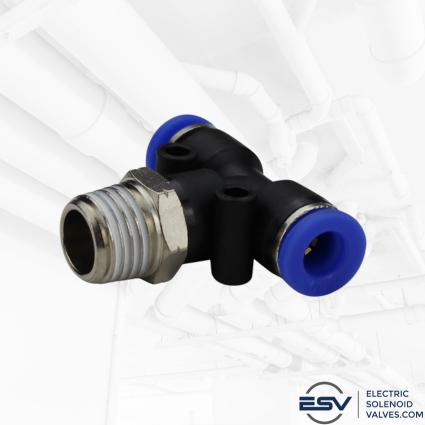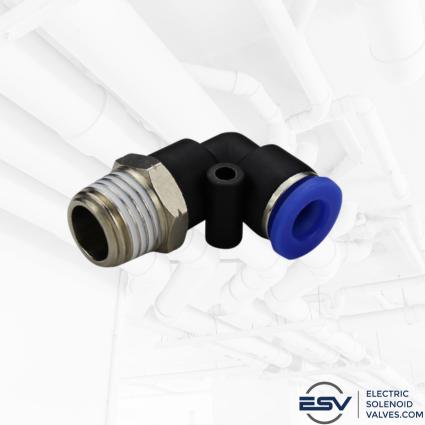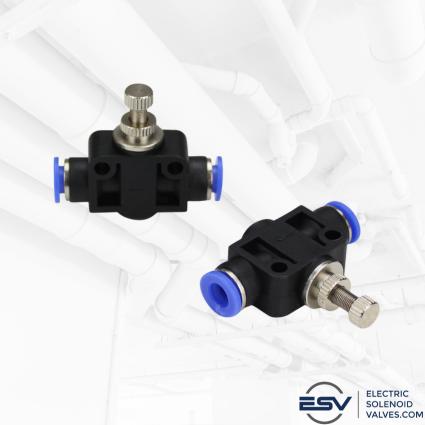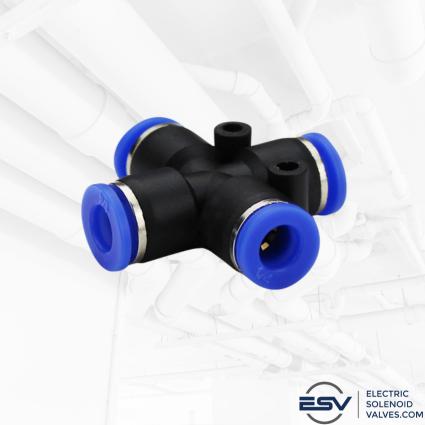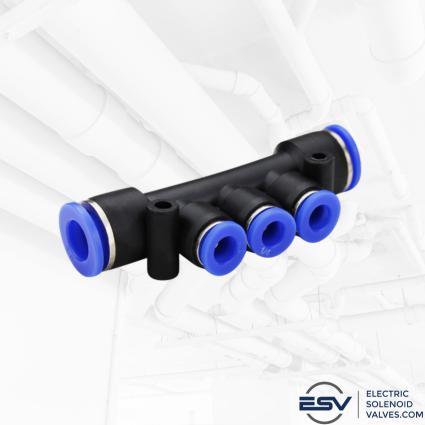Jan 22nd 2025
Understanding The Right Time to Replace Push Connect Fittings in Industrial Fluid Flow Applications
Push connect fittings are the backbone of many fluid systems, offering quick, leak-free connections for industrial, commercial, and even medical applications. From aerospace systems to water distribution, their reliability is unparalleled—until they start to fail. Ignoring worn-out push connect fittings can lead to costly downtime, safety risks, and compromised system efficiency.
In this guide, we’ll dive into the key factors that influence fitting lifespan, how to spot failure signs early, and maintenance tips to extend their usefulness. Whether you manage a high-pressure industrial setup or a smaller pneumatic system, knowing when to replace push connect fittings can save you time, money, and headaches.
Branch Tee Connector Push Connect Fitting
Push connect fittings undergo wear and tear over time. That means their lifespan is finite, and operators or users must understand when it is the right time to replace them. Delays or continuing operations with damaged or aging push connect fittings expose the systems they work for to safety concerns and can cause undesirable downtime, which is costly and injurious in some situations.
This article provides a quick lifespan analysis of push connect fittings, offering insights on the indicators of component failure, best practices for maintaining and extending component lifespan, and general guidelines for replacing push connect fittings in different industrial applications.
Factors Influencing the Lifespan of Push Connect Fittings
Push connect fittings have varying lifespans depending on their cycling requirements, operating environment conditions and the properties of the fabrication materials. Other external factors, like the chemical composition of the service media, surface treatment techniques and handling, affect the longevity and reliability of these components. Broadly, metallic push connect fittings have a longer lifespan than those made from plastics (or polymers). Push connect fittings for aggressive chemical media service or those exposed to high pressure and temperature are also prone to premature damage. Finally, fittings can have a short lifespan if they experience repetitive dynamic stresses from system vibrations or regular connection and disconnection. Here is a closer look at the effects of these factors on the longevity of push connect fittings.
Male Elbow Connector Push Connect Fitting
System Operating Conditions
Push connect fittings are designed to accommodate specific system pressure and temperature. The choice of push connect fitting for any fluid application should bear the appropriate pressure and temperature rating to prevent any performance issues. Exposing push connect fittings to high system pressure and temperature leads to the steady degradation of seals, making them ineffective in the long run.
Another system-related issue that can affect the lifespan of push connect fittings is exposure to aggressive chemicals. Such chemicals periodically corrode fittings and weaken seals, which protect against leakages and fugitive emissions. Seal corrosion rates are higher if the seal material is incompatible with the chemical composition of the service media. Choose a fitting with seal materials compatible with chemical media to prevent premature fitting corrosion.
Push connect fittings can have a shorter lifespan if exposed to aggressive environments. Some fitting materials cannot withstand exposure to ultraviolet rays or contamination from dust and debris. Other impurities in the surrounding environment can expedite surface damage of seals, rendering them unsafe for use after a short service period.
Inline Air Flow Speed Control Valve Push Connect Fitting
Push-Connect Fitting Material Properties
Push connect fittings are made from different material grades. Each material offers unique properties, making them suitable for specific fluid flow applications. Push connect fittings can be metallic or plastic. Metallic push connect fittings, made from steel, brass, bronze and copper, are preferable for aggressive high-pressure environments. They can withstand high temperatures and have better durability. Plastic fittings include those containing high-grade polyethylene or nylon material. These materials produce fittings with excellent corrosion resistance, are lightweight, and are popular in air and water supply systems.
Choosing the right fitting material ensures dependable and durable fitting service. Do not implement plastic push connect fittings in high-pressure and temperature environments. Additionally, ensure the sealing material is compatible with the service fluids and the temperature variations in the system.
Dynamic Stresses
Push connect fittings are vital for creating quick connections between piping sections to achieve certain fluid flow conditions. While their design fosters efficiency, they are prone to dynamic stresses, some of which may negatively impact their lifespan. Push connect fittings in high vibration or motion environments can easily loosen. Their seals can wear prematurely, affecting the flow control and sealing capabilities.
Dynamic stress can also emerge from repetitive thermal expansion and contraction due to temperature fluctuation of the service media. The expansion and contraction can significantly deform seals, making them ineffective over time. Push connect fittings can have shorter lifespans if repeatedly connected and disconnected. Connection and disconnection create strain on fittings, accelerating their damage and lowering operational lifespan.
Signs Of Push Connect Fitting Failure
Push connect fittings exhibit several signs of failure, indicating they are approaching the end of their useful lives. Early identification of these signs of failures is essential for averting safety issues, unexpected downtime and damage to equipment. Some popular signs of push connect fitting failure are:
- Unexpected disconnections
- Leakages
- Visible damage
Unexpected Disconnections
Push connect fittings can disconnect prematurely, even when the fluid conditions are normal. Unexpected fitting disconnection can happen if internal fitting components are worn out. It may also occur if fittings have damaged locking mechanisms or worn-out seals.
Push connect fittings experiencing unexpected disconnections require repetitive reseating. The loose connection between fittings and adjacent tubing indicates significant wear on the fitting interface. Unexpected disconnections can cause rampant leakages that can negatively impact workflow and safety.
Always troubleshoot the cause of unexpected or frequent fitting disconnections. Change the tubing or refine the seating surface If the disconnection is due to the distortion of the tube-fitting connection interface. Replace all fittings with worn-out internal surfaces, locking mechanisms or seals.
Cross Union Push Connect Fitting
Leakages
Fluid leakage around the fitting indicates a damaged push connect fitting. Leakage quantities vary depending on the level of damage. While leakages can also happen due to poor installation, most leaks point to worn-out push connect seals. The effect of small leakages around the push connect fitting can result in other functional failures, including reduced flow rates. Such functional failures lower the efficiency of fluid systems, making them unsustainable. However, reduced flow rates are not caused by worn-out push fittings alone. They can happen if tubings or fittings have minor obstructions.
Confirm if flow rate variations primarily arise from tube or fitting obstructions or wrong installation (fitting or alignment). If that is not the case, proceed with inspecting the seating and sealing surfaces. Any signs of wear warrant the replacement of the push connect fitting.
Visible Damage
The easiest way to identify damage on push connect fittings is by conducting a thorough physical inspection. One can identify several surface defects on the fittings and deduce their causes, paving the way for implementing appropriate corrective measures. Some visible fitting degradation signs are:
- Deformation- the fitting body could bulge or warp, losing its original shape or size. Surface warping occurs due to internal stress and structural strain from fluid pressure and temperature.
- Visible cracks- cracks on the fitting body occur due to fatigue from exposure to the operating environment. The fitting undergoes repetitive fatigue, which ultimately causes cracks on the surface of the fitting material. Such cracks reduce the pressure and temperature-bearing capabilities of the fitting.
- Discoloration- the color of the fitting may change over time. Discoloration happens if the fitting is exposed to UV rays, high temperature or chemical media. Massive discoloration may indicate a significant weakening of the fitting material, making it ineffective against the fluid operating conditions.
Pro Tip: Immediately replace push connect fittings exhibiting physical signs of damage. Do not subject push connect fittings with surface distortion or visible cracks to additional system pressure; they may rupture or explode, leading to dire operational and safety consequences.
Maintenance Practices
One of the effective ways to extend the lifespan of push connect fittings is to develop and sustain a preventive maintenance schedule. It is helpful for proactively identifying and rectifying telltale signs of failure or damage. Preventive maintenance of flow control devices does not have to be costly to deliver results. It combines low-cost practices like visual inspection, fitting exercising (opening and closing), leak testing and tracking performance parameters. Here are a few inspirations one can leverage to maintain push connect fittings and enhance their functionality in fluid applications.
- Visual inspection - create a schedule for facility-wide inspection of push connect fittings. Create a list of all push connect fittings, their specifications and locations. Identify an ideal timeline to inspect them, creating a simple checklist to certify if they are in good condition or require replacement. The inspection can be monthly, quarterly or semi-annually, depending on the fitting operating environment and conditions. Check if the push connect fittings exhibit fatigue, surface deformation, discoloration or leakages. Keep a substantial stock of fittings to replace those that fail the visual inspection fitness test.
- Leak testing - it is an advanced maintenance practice that evaluates the safety and reliability of push connect fittings in a piping system. It is a more effective maintenance practice for fittings in tubings handling gases, chemicals or hazardous fluids where leakages and fugitive emissions are prohibited. Leak testing can utilize dye penetrants to identify minor cracks on the surface of the push connect fittings. Alternatively, subject the piping system to pressurized soapy fluid and observe how the fittings behave under the pressurized fluid. The supply test pressure should be within the fitting and piping design limits to avoid damaging them.
- Data gathering - collecting regular fitting performance information can offer valuable insights into their health and reliability. Gather information on parameters like flow rates or pressure variations over time. With this data, one can identify moments when performance significantly drops and use it to troubleshoot the impending failure or damage to push connect fittings.
5 Port Manifold, Push Connect Pneumatic Fitting
Guidelines For Replacing Push Connect Fittings
Under what circumstances can you decide to replace push connect fittings, particularly if they can still provide fluid control? Replacing aging or damaged push connect fittings mitigates the negative impacts of unplanned downtime and safety risks. However, there is a financial constraint associated with such replacement. One has to perform a quick cost-risk analysis before replacing multiple fittings in a single application or facility. One should also consider the criticality of a fitting in an application before deciding whether or not to replace it. The replacement fitting should match the system performance metrics or offer better operating conditions.
The general guidelines for replacing push connect fittings in different industrial applications are:
- Replace push connect fittings in high-pressure fluid applications with suitable alternatives within 12-18 months of service. The replacement timeline can be shorter if the components in the operating environment subject the fittings to rapid wear and tear. Fittings in low-pressure, less aggressive environments can operate effectively beyond the recommended 12-18 months of service.
- Conduct compatibility studies between push connect fitting materials and the service fluid. Check the manufacturer’s compatibility charts to identify if the fittings are usable in aggressive and chemical environments. Replace the fittings at the recommended intervals as indicated in the compatibility charts. Consult your vendor if you cannot access this information.
- Keep a detailed record of push connect fittings installation dates to track their age and performance over time. Such records enable operators or maintenance teams to pinpoint which fittings to replace based on manufacturer-recommended timelines. One can always replace aging fittings even though they do not show physical signs of damage or failure based on their installation dates.
Pro Tip: Refer to chemical/material compatibility charts to ensure new fittings match system requirements.
Final Words
Replacement timelines for push connect fittings depend on several operational and design variables. Always choose high-quality fittings like the ones in the Electric Solenoid Valves online catalog. Track the installation dates and the performances of the fittings, paying attention to their physical appearances and functionality. Consult our valve experts if you do not know when to replace a push connect fitting or which alternative you should use based on the operating environment and the properties of the service fluids.


